必修三英语unit1情态动词的用法
- 格式:ppt
- 大小:728.50 KB
- 文档页数:16
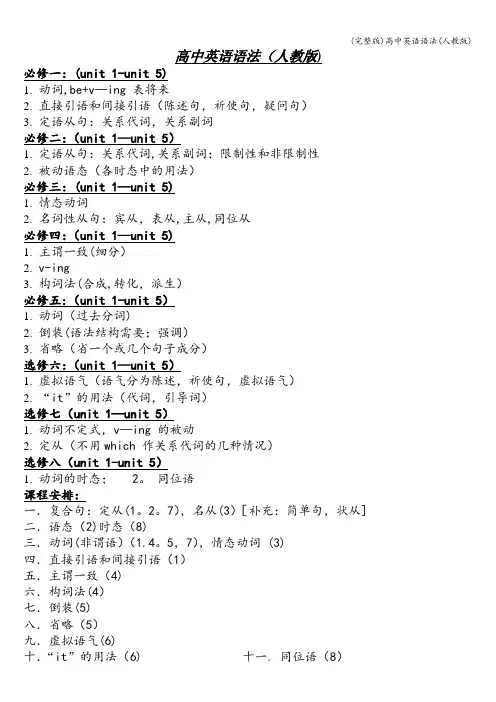
(完整版)高中英语语法(人教版)
高中英语语法(人教版)
必修一:(unit 1-unit 5)
1.动词,be+v—ing 表将来
2.直接引语和间接引语(陈述句,祈使句,疑问句)
3.定语从句:关系代词,关系副词
必修二:(unit 1—unit 5)
1.定语从句:关系代词,关系副词;限制性和非限制性
2.被动语态(各时态中的用法)
必修三:(unit 1—unit 5)
1.情态动词
2.名词性从句:宾从,表从,主从,同位从
必修四:(unit 1—unit 5)
1.主谓一致(细分)
2.v-ing
3.构词法(合成,转化,派生)
必修五:(unit 1-unit 5)
1.动词(过去分词)
2.倒装(语法结构需要;强调)
3.省略(省一个或几个句子成分)
选修六:(unit 1—unit 5)
1.虚拟语气(语气分为陈述,祈使句,虚拟语气)
2.“it”的用法(代词,引导词)
选修七(unit 1—unit 5)
1.动词不定式,v—ing 的被动
2.定从(不用which 作关系代词的几种情况)
选修八(unit 1-unit 5)
1.动词的时态; 2。
同位语
课程安排:
一.复合句:定从(1。
2。
7),名从(3)[补充:简单句,状从]
二.语态(2)时态(8)
三.动词(非谓语)(1.4。
5,7),情态动词 (3)
四.直接引语和间接引语(1)
五.主谓一致(4)
六.构词法(4)
七.倒装(5)
八.省略(5)
九.虚拟语气(6)
十.“it”的用法(6) 十一. 同位语(8)。

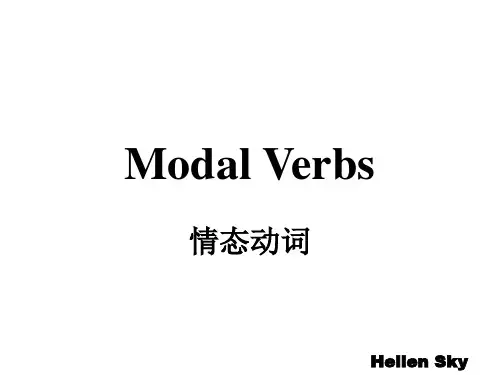

人教版高中英语必修三语法总结高中英语必修三语法主要考点有情态动词、名词性从句、同位语从句等,下面是具体的高中英语必修三语法,仅供参考。
1英语必修三有哪些语法要学考点一情态动词(unit1,unit2)一、情态动词的特点:1.没有人称和数的变化。
2.有些情态动词有过去式的变化:e.g.will→would,can→could,may→might,dare→dared二、情态动词的否定式:情态动词+not+动词原形cannot:can’t,mustnot:mustn’t,neednot:needn’t三、情态动词的用法及相互区别,是考试的内容之一1.can,beabletobeableto表示经过努力后,能够做到;beableto有多种形式的变化。
can1).表示体力或脑力方面的能力;2).表示允许、可能性。
could是can的过去式,表示过去有能力及过去存在的可能性;用于疑问句表示委婉地提出问题。
1)Thefirespreadthroughthehotelveryquicklybuteveryone____getout.(NMET97)A.hadtoB.wouldC.couldD.wasableto2)-Willyoustayforlunch?-Sorry,__.Mybrotheriscomingtoseeme.(NMET99)A.Imustn’tB.Ican’tC.Ineedn’tD.Iwon’t2.may表示询问或说明一件事可不可做;表示某事有可能发生。
might是may的过去式;用在疑问中比may委婉、客气。
1)-MayItakethisbookoutofthereading-room?-No,youmustn’t.(Yes,youmay.)2)-MightImakeasuggestion?-Yes,youmay.3.must1).表示必须要做的事:必须2)表示很有把握的推断:一定,准是。
have(has)to:have(has)gotto必须,不得不。
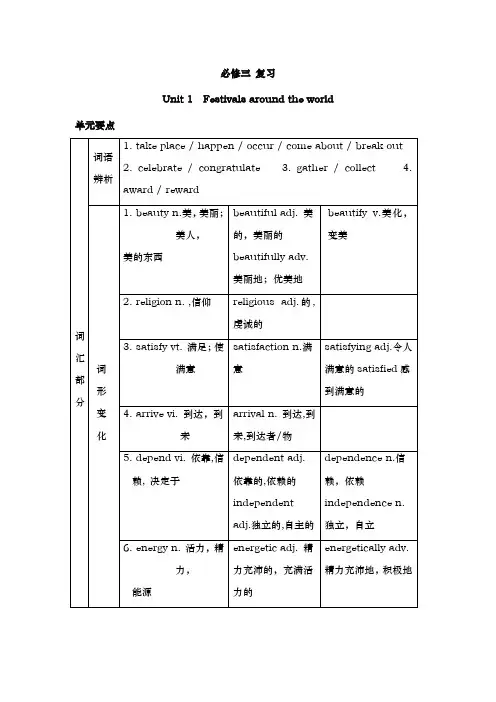
必修三复习Unit 1 Festivals around the world 单元要点语言要点Ⅰ.词语辨析Ⅱ.词性变化Ⅲ.重点词汇1. mean (meant, meant) vt.&vi. 意思是;意味着;打算;预定[典例]1). The sign means that the road is blocked. 这个标志表示此路不通。
2). What do you mean to do with it? 你打算把它怎样处理?3). I mean you to work as our spokesman. 我想请你当我们的代言人。
[重点用法](sth.) mean doing sth. 意味着… (sb) mean to do sth. 打算做… had meant to do sth. 本来打算做某事be meant for 打算作……用;打算给…(sth.) be meant to do sth. 被预定/指定/认为做某事What do/did you mean by...? “你……是什么意思?”[练习] 按要求填空或翻译。
1). Can you tell me what this sentence______ (mean)?2). Your friendship ______ (mean) a great deal ______ (介词) me.3). In some parts of London, missing a bus means ______ (wait) for another hour.4). What did he mean ______ (介词) saying that remark?5). I ______ ______ ______ ______(本来打算来)yesterday, but I had an unexpected visitor.6). 这些房间是打算用作少年活动中心的。
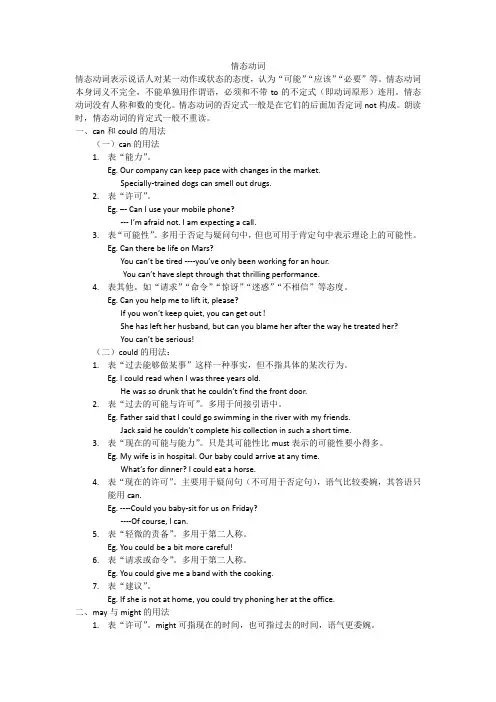
情态动词情态动词表示说话人对某一动作或状态的态度,认为“可能”“应该”“必要”等。
情态动词本身词义不完全,不能单独用作谓语,必须和不带to的不定式(即动词原形)连用。
情态动词没有人称和数的变化。
情态动词的否定式一般是在它们的后面加否定词not构成。
朗读时,情态动词的肯定式一般不重读。
一、can和could的用法(一)can的用法1.表“能力”。
Eg. Our company can keep pace with changes in the market.Specially-trained dogs can smell out drugs.2.表“许可”。
Eg. –- Can I use your mobile phone?--- I’m afraid not. I am expecting a call.3.表“可能性”。
多用于否定与疑问句中,但也可用于肯定句中表示理论上的可能性。
Eg. Can there be life on Mars?You can’t be tired ----you’ve only been working for an hour.You can’t have slept through that thrilling performance.4.表其他。
如“请求”“命令”“惊讶”“迷惑”“不相信”等态度。
Eg. Can you help me to lift it, please?If you won’t keep quiet, you can get out!She has left her husband, but can you blame her after the way he treated her?You can’t be serious!(二)could的用法:1.表“过去能够做某事”这样一种事实,但不指具体的某次行为。
Eg. I could read when I was three years old.He was so drunk that he couldn’t find the front door.2.表“过去的可能与许可”。
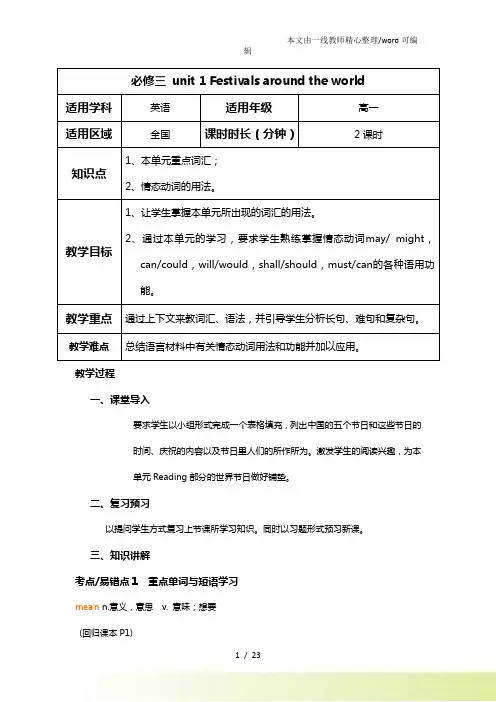
必修三unit 1 Festivals around the world 适用学科英语适用年级高一适用区域全国课时时长(分钟)2课时知识点1、本单元重点词汇;2、情态动词的用法。
教学目标1、让学生掌握本单元所出现的词汇的用法。
2、通过本单元的学习,要求学生熟练掌握情态动词may/ might,can/could,will/would,shall/should,must/can的各种语用功能。
教学重点通过上下文来教词汇、语法,并引导学生分析长句、难句和复杂句。
教学难点总结语言材料中有关情态动词用法和功能并加以应用。
教学过程一、课堂导入要求学生以小组形式完成一个表格填充,列出中国的五个节日和这些节日的时间、庆祝的内容以及节日里人们的所作所为。
激发学生的阅读兴趣,为本单元Reading部分的世界节日做好铺垫。
二、复习预习以提问学生方式复习上节课所学习知识。
同时以习题形式预习新课。
三、知识讲解考点/易错点1 重点单词与短语学习mean n.意义,意思v. 意味;想要(回归课本P1)Festivals are meant to celebrate important times of year.[归纳拓展]mean to do 打算做某事be meant to do 被要求做…mean doing 意味着….eg. I never meant him to work for us.Passing the entrance examination means being admitted into college.take place发生(回归课本P1)Discuss when they take place, what they celebrate and what people do at that time. [归纳拓展] take place/happen/occur/break out/come about(1)take place 其“发生”是按意图或计划进行,无偶然性,无被动语态。
](https://uimg.taocdn.com/b56df0754b73f242336c5f6b.webp)
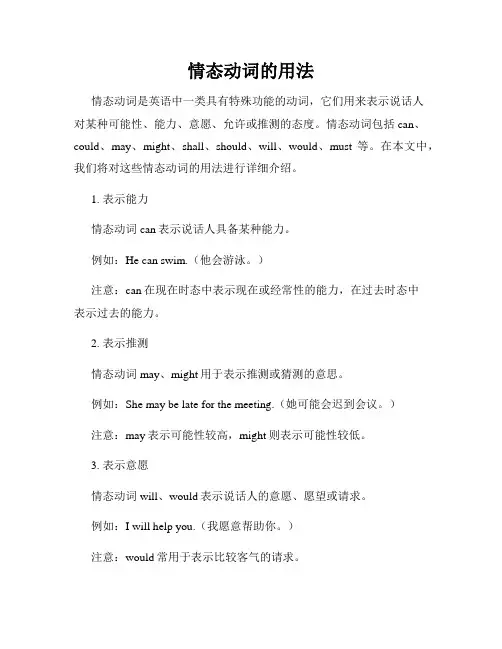
情态动词的用法情态动词是英语中一类具有特殊功能的动词,它们用来表示说话人对某种可能性、能力、意愿、允许或推测的态度。
情态动词包括can、could、may、might、shall、should、will、would、must等。
在本文中,我们将对这些情态动词的用法进行详细介绍。
1. 表示能力情态动词can表示说话人具备某种能力。
例如:He can swim.(他会游泳。
)注意:can在现在时态中表示现在或经常性的能力,在过去时态中表示过去的能力。
2. 表示推测情态动词may、might用于表示推测或猜测的意思。
例如:She may be late for the meeting.(她可能会迟到会议。
)注意:may表示可能性较高,might则表示可能性较低。
3. 表示意愿情态动词will、would表示说话人的意愿、愿望或请求。
例如:I will help you.(我愿意帮助你。
)注意:would常用于表示比较客气的请求。
4. 表示推测的过去情态动词must常用于表示对过去情况的推测或肯定。
例如:He must have missed the bus.(他肯定错过了公交车。
)注意:must用于表示对过去情况的肯定,而might用于表示对过去情况的推测。
5. 表示义务或必要性情态动词must表示对义务、必要性或确定性的肯定。
例如:You must finish your homework.(你必须完成作业。
)6. 表示建议或应该情态动词should表示建议或应该。
例如:You should go to bed early.(你应该早点睡觉。
)注意:should还可以表示对过去情况的推测,例如:He should have arrived by now.(他现在应该已经到达了。
)7. 表示允许或许可情态动词can与may可以用于表示许可或允许。
例如:Can I borrow your pen?(我可以借你的钢笔吗?)8. 表示可能性情态动词could用于表示可能性。

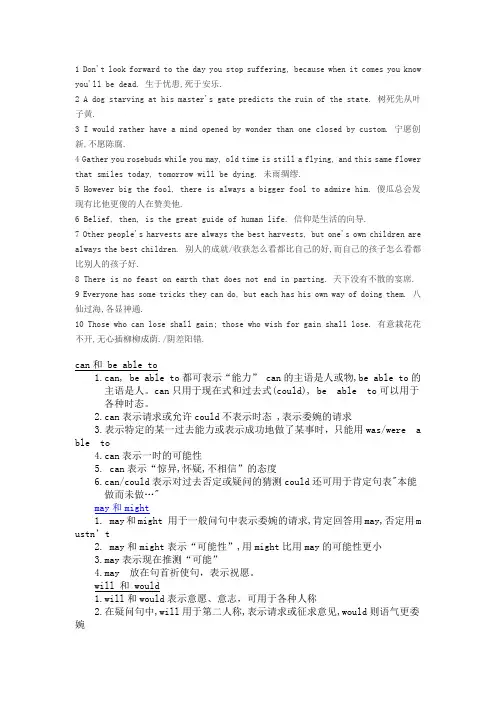
1 Don't look forward to the day you stop suffering, because when it comes you know you'll be dead. 生于忧患,死于安乐.2 A dog starving at his master's gate predicts the ruin of the state. 树死先从叶子黄.3 I would rather have a mind opened by wonder than one closed by custom. 宁愿创新,不愿陈腐.4 Gather you rosebuds while you may, old time is still a flying, and this same flower that smiles today, tomorrow will be dying. 未雨绸缪.5 However big the fool, there is always a bigger fool to admire him. 傻瓜总会发现有比他更傻的人在赞美他.6 Belief, then, is the great guide of human life. 信仰是生活的向导.7 Other people's harvests are always the best harvests, but one's own children are always the best children. 别人的成就/收获怎么看都比自己的好,而自己的孩子怎么看都比别人的孩子好.8 There is no feast on earth that does not end in parting. 天下没有不散的宴席.9 Everyone has some tricks they can do, but each has his own way of doing them. 八仙过海,各显神通.10 Those who can lose shall gain; those who wish for gain shall lose. 有意栽花花不开,无心插柳柳成荫./阴差阳错.can和 be able to1.can, be able to都可表示“能力” can的主语是人或物,be able to的主语是人。
高中必修三英语的知识点高中必修三英语知识点1Unit1 Festivals around the world【重点词汇、短语】1. take place 发生2. religious 宗教的3. in memory of 纪念4. belief 信任,信心,信仰5. dress up 盛装,打扮6. trick 诡计,窍门7. play a trick on 搞恶作剧,诈骗8. gain 获得9. gather 搜集,集合10. award 奖品,授予11. admire 赞美,钦佩12. look forward to 期望,盼望13. day and night 日夜14. as though 好像15. have fun with 玩的开心16. permission 许可,允许17. turn up 出现,到场18. keep one’s word 守信用19. hold one’s breath 屏息20. apologize道歉21. obvious 显然的22. set off 出发,动身,使爆炸【重点句型】1. Please make sure when and where the accident took place.请查清楚事故是何时何地发生的。
2. Some festival are held to honour the dead, or satisfy and please the ancestors, who could return either to help or to do harm.还有一些节日,是为了纪念死者、满足或取悦祖先,因为(祖先们)有可能回到世上帮助他们,也有可能带来危害。
3. In Japan the festival is called Obon,when people should go to clean the graves and light incense in memory of their ancestors.(非限制性定语从句)在日本,这个节叫孟兰盆节,在这个节日里,人们要上坟、扫墓、烧香,以缅怀祖先。
GrammarTeaching Goals: 1. To check what has been learned yesterday.2. To enable Ss to master some new words and expressions.3. To get Ss to have knowledge of the grammar point: the model verb Teaching Procedures:Step 1. Revision1. Ask Some Ss to retell the reading text.2. Ask Ss to answer the following question to see whether they did their homework or not.How many festivals are mentioned in our text?Step 2. Word studyPurpose: To consolidate the words and phrases in the text.Finish Ex1Purpose: To enable Ss to master some new words and expressions.Ex2 Many people think that Christmas is a western __________, but in fact it is really a worldwide holiday. Christmas actually as a _______ festival celebrated by _________ around the world. Its ______ is around the 3rd or 4th century AD, when the _______ of remembering Jesus’ birth on December 25th first started. Today, of course, many people celebrate Christmas __________ it were just a holiday to ______________ family, rather than a holiday about a _______.Suggested Answers:celebration, religious, Christians, origin, custom, as though, have a fun with, beliefStep 3. Grammar point1. Explain for Ss the grammar point: the modal verb(1) can/could 可以表示能力、许诺、请求或某种可能性,could还可用于:①提出委婉的请求,(注意在回答中不可用could)。
2021人教版必修三unit1 《festivals around the world》word教案Teaching aims and demands1.topic:1>Festivals2> how festivals begin3>how to celebrate festivals2.function:1>RequestEg: Could you please…?Could I have …?I look forward to doing…2>ThanksEg: It’s a pleasure. /Don’t mention it.It’s very kind of you to…I’d love to …Thank you very much./Thanks a lot.You are most welcome.3.vocabulary:4.grammar: 情态动词的用法Jin can speak English well. (ability)Could you please show me the way to …? (request)May we see the awards for the team? (permission)She might give you … (possibility)The whole family will come for dinner. (promise)Often he would dress up like a rich man. (past habit)We would be there with our friends. (promise)II. Key pointsThe First PeriodNew words and Expressions1.take place 为不及物动词短语,无被动语态,无进行时,指事先打算或预想到的情况的发生。
高一英语英语必修3Unit1语法情态动词课件一、教学内容本节课我们将学习高一英语必修3 Unit 1的语法部分,重点探讨情态动词的用法。
教材涉及章节为1.1和1.2,内容包括情态动词的定义、用法和常见情态动词的辨析。
二、教学目标1. 了解情态动词的概念,掌握情态动词的基本用法。
2. 学会辨析常见情态动词,如:can, may, must, need等,并能正确运用到句子中。
3. 提高学生的英语听说读写能力,通过小组讨论、课堂展示等形式,培养学生的合作精神。
三、教学难点与重点重点:情态动词的基本用法和辨析。
难点:如何正确运用情态动词表达推测、请求、建议等意义。
四、教具与学具准备1. 教具:多媒体课件、黑板、粉笔。
2. 学具:教材、笔记本、字典。
五、教学过程1. 导入:通过一个实践情景引入,让学生思考如何用英语表达“能力、请求、推测”等概念。
2. 新课内容:讲解情态动词的定义、用法,通过例句展示不同情态动词的用法。
3. 例题讲解:分析教材中的例题,讲解解题思路,引导学生正确使用情态动词。
4. 随堂练习:布置教材中的练习题,让学生当堂完成,并及时给予反馈。
5. 小组讨论:让学生分成小组,讨论如何在不同情境下使用情态动词,并进行课堂展示。
7. 作业布置:布置课后作业,要求学生运用所学知识完成。
六、板书设计1. 情态动词的定义和用法2. 常见情态动词的辨析3. 课堂练习和答案七、作业设计1. 作业题目:(1)完成教材1.2中的练习题。
(2)用情态动词编写一段对话,描述一个实践情景。
2. 答案:八、课后反思及拓展延伸1. 反思:本节课的教学效果,学生的掌握程度,以及教学过程中的不足。
2. 拓展延伸:鼓励学生在课后阅读英语文章,观察情态动词在不同语境下的使用,提高英语实际运用能力。
同时,布置一道拓展题目,让学生尝试用所学情态动词描述一个更复杂的实践情景。
重点和难点解析一、教学难点与重点1. 重点:情态动词的基本用法和辨析。
Unit1 Can you play the guitar的语法you play the guitar 你会弹吉他吗—Yes, I can. 是的,我会。
—No, I can’t. 不,我不会。
①情态动词can的用法:情态动词无人称和数目的变化,不能独立使用作谓语,后面必须接动词原形,情态动词和动词原形一起构成谓语。
Can you...用来询问对方能否做某事,意思是“你能/会……吗”,肯定回答用“Yes,I can.”否定回答用“No,I can’t.” can(能、会),may(可以;可能),must(必须) , need都是情态动词,后面跟动词原形。
其否定结构在后面加上not,can not通常缩写为can’t;must not缩写为mustn’t;may not一般不缩写。
含情态动词的句子一般疑问句是把情态动词提到句首,否定句是在情态动词后加not。
Can you play the piano,the trumpet,the drums,or the guitar你会弹奏钢琴,吹喇叭,敲鼓,或者弹吉他吗【剖析】此句为简单的选择疑问句,即提问者提供两种或两种以上情况,让对方从中作出选择的句子。
它的基本结构是:一般疑问句+or+一般疑问句(后一部分与前一部分相同的成分常常省略)。
or连接的是两个并列的成分,要求词性一致。
【拓展】 1)回答时,不用yes或no,而是选择其中一种回答。
2)在读法上,or的前一部分用升调,后一部分用降调。
如:—Are you in Class 1 or Class 2 —I’m in Class 1. / I’m in Class 2.语法·聚焦“能”说“会”道的can【can的才艺展示】1.表示能力,通常指在体力或脑力方面的能力,意为“能;会”。
如:He can speak English.他会说英语。
2.表示许可,意为“可以”,这时可以和may通用,但是比may较正式。